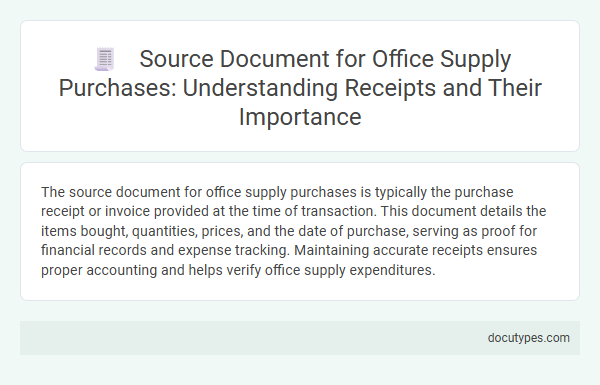The source document for office supply purchases is typically the purchase receipt or invoice provided at the time of transaction. This document details the items bought, quantities, prices, and the date of purchase, serving as proof for financial records and expense tracking. Maintaining accurate receipts ensures proper accounting and helps verify office supply expenditures.
Introduction to Source Documents in Office Purchases
Source documents are essential records that capture the details of office supply purchases. They provide verifiable evidence for financial transactions and support accurate accounting.
- Definition of Source Document - A source document is the original paper or electronic record that verifies a financial transaction.
- Common Types in Office Purchases - Receipts, invoices, and purchase orders serve as primary source documents for office supply acquisitions.
- Role in Financial Accountability - Your office uses these documents to ensure accurate bookkeeping and auditing of supply expenses.
What is a Receipt?
A receipt is the primary source document for office supply purchases. It provides detailed proof of the transaction, including items bought, quantities, prices, and the date of purchase.
Your receipt serves as evidence for accounting records and expense tracking. It ensures accurate documentation of business expenses and supports reimbursement or tax purposes.
Key Components of a Professional Receipt
The source document for office supply purchases is a professional receipt that validates the transaction and serves as proof of purchase. A detailed and well-organized receipt streamlines accounting and inventory management.
- Date and Vendor Information - The receipt must include the purchase date and vendor details to confirm the authenticity of the transaction.
- Itemized List of Supplies - Each office supply purchased should be clearly listed with quantities, descriptions, and prices.
- Total Amount and Payment Method - The receipt should display the total cost along with the payment method used to finalize the purchase.
Importance of Receipts in Office Supply Management
The source document for office supply purchases is the receipt, which provides detailed proof of the transaction. It records essential information such as date, vendor, items purchased, quantities, and costs.
Receipts play a crucial role in office supply management by enabling accurate tracking and budgeting. You can use them to verify expenditures, ensure accountability, and streamline inventory control processes.
Receipts as Proof of Purchase
| Topic | Details |
|---|---|
| Source Document for Office Supply Purchases | Receipts serve as the primary source document for office supply purchases, providing official proof of transaction between the buyer and the supplier. |
| Definition of Receipts | A receipt is a written or electronic document issued at the point of sale that confirms the purchase of office supplies, including itemized details, price, date, and vendor information. |
| Key Elements on Receipts | Receipts typically include purchase date, vendor name, description of office supplies, quantity, unit price, total amount, and payment method, all verifying the legitimacy of the purchase. |
| Importance of Receipts as Proof of Purchase | Receipts validate the financial transaction for accounting records, budget tracking, tax deduction claims, and audit purposes, establishing legal evidence of expenditure. |
| Usage in Accounting | Receipts are used to record expenses accurately, facilitate reimbursement processes, and support bookkeeping entries related to office supply procurement. |
| Retention and Archival | Proper storage of receipts, whether physical or digital, is essential for future reference, compliance with regulatory standards, and resolving any discrepancies in office supply purchases. |
Role of Receipts in Financial Record-Keeping
The source document for office supply purchases is typically the receipt provided at the time of transaction. Receipts serve as essential evidence in financial record-keeping, verifying the date, amount, and vendor details for accurate bookkeeping. You rely on these documents to ensure transparency and accountability in office expense tracking.
Receipts and Tax Compliance for Businesses
The source document for office supply purchases is typically a receipt, which serves as proof of transaction. Receipts play a crucial role in maintaining accurate financial records and ensuring tax compliance for businesses.
- Receipt as Proof of Purchase - A receipt provides detailed information about the transaction, including item descriptions, quantities, prices, and date of purchase.
- Tax Compliance Documentation - Businesses must retain receipts to support deductible expenses and verify claims during tax audits.
- Record-Keeping Requirement - Properly organized receipts help businesses track office supply expenditures and maintain transparency in accounting practices.
Maintaining organized receipts is essential for legal compliance and effective financial management in businesses.
Best Practices for Storing and Organizing Receipts
The source document for office supply purchases is the receipt provided at the point of sale, detailing items bought, prices, and transaction date. Best practices for storing receipts include using digital scanning to create organized electronic records, which facilitates easy retrieval and reduces physical clutter. Categorizing receipts by date and supplier, along with regular backups, ensures efficient expense tracking and simplifies auditing processes.
Common Mistakes to Avoid with Office Purchase Receipts
The source document for office supply purchases is typically the purchase receipt provided by the vendor. This receipt serves as proof of transaction and is essential for accurate record-keeping and expense tracking.
Common mistakes to avoid with office purchase receipts include misplacing or losing the receipt, which can lead to difficulties during audits. Another frequent error is failing to verify that the receipt matches the purchase order in terms of items and amounts. Additionally, neglecting to record the receipt promptly can result in incomplete financial records and budgeting errors.
What Is the Source Document for Office Supply Purchases? Infographic

